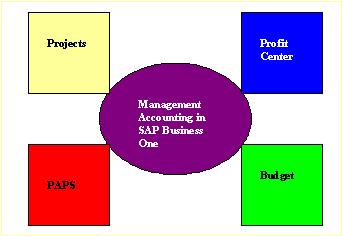Management Accounting in SAP Business One
Management Accounting, other wise known, as Cost Accounting (in SAP Business One) is one of the functionalities that can be leveraged in SAP Business One. Management Accounting is important for not only SMBs, but also large corporations because it drives internal reporting. Irrespective of the size of a company, the ability to be able to manage the internal flow or trend of expenses and revenue is key to success. More level of details as to the performance of individual business units can be seen and reviewed accordingly.
The bottom line therefore is that, internally consumed reports are used for critical decision making.Management Accounting in SAP Business One is made possible by four major concepts namely: Projects, Profit Centers, Budget and Purchase Accounts Posting System (PAPS).

Projects
SAP Business One allows you to track expenses and revenues of your projects. In a typical company, project differs in shapes and sizes. As a matter of fact, project doesn't have to be a physical or construction activity before it can be used. It could come in some form of "soft form" e.g. Letter of Credits (LC) and special orders. A company that does importation of goods can use projects to track the profitability of individual LCs. Also, a paper manufacturing industry can use projects to track the profitability of a particular special order against another special order for a given product.To create projects in SAP Business One, access the path below:Administration > Set up > Financials > Define Projects
Projects can be attached to a document both at the header level and line level. In whichever case, the corresponding journal entries created inherit the project definition. Furthermore, projects can be tied to business partner and general ledger accounts, thus you don't have to manually assign projects to transactions that relates to the BP or G/L account. The Transaction report by Project allows you to analyze transaction posted for project(s) based on defined criteria.
Profit Centers
In SAP Business One, profit centers and cost centers are jointly managed by the profit center functionality. Ideally, an organization has varying sections or business units where costs are incurred or revenues are generated. For example, the admin departments in most firms do not really generate revenue, but incurs expenses. The sales department on the other hand, generates revenue and also incur expenses e.g. transportation fee. Hence, the profit center feature allows you to track the profitability or otherwise of these departments or cost centers In profit center management, two important phenomenons are worth mentioning namely: Direct expenses/revenue and Indirect expenses/revenue.
Direct expenses/revenue is the expenses/revenue that can be wholly linked to a business unit or department while the indirect expenses/revenue cannot be wholly assigned to a business unit or department. For example, electricity bill. The number of departments in an organization shares the bill. The sharing formula is based on defined parameters like size area. SAP Business One uses the distribution rule feature to enforce this sharing automatically and it can be updated when business rule changes. You can define and manage distribution rules under Financial > Cost Accounting > Define Distribution Rules. Profit centers can be defined in SAP Business One by accessing the path below.Financials > Cost Accounting > Define Profit Centers
Furthermore, for more detailed or summarized level of reporting, sort codes can be used to group profit centers together. The architecture generated in this case is like a parent - child relationship. Profit centers can be assigned to revenue and expense accounts so that when transactions are posted in the system, these accounts are automatically updated. Profit and loss statement can be generated for profit centers.
Budget
Budget is another management accounting tool that can be used in SAP Business One. Budget can be defined by accessing this path: Financial > Budget > Define Budget. The budget functionality is used to control corporate expenses. This implies that budget can be defined for a G/L account or project as the case may be. Depending on the maximum amount specified in the definition of the budget, transaction could be blocked, with or without warning when budget is exceeded. Budget scenarios can also be created in SAP Business One. This allows you to do some kind of budget comparism between say, optimistic, pessimistic and main budgets. Furthermore, budget distribution methods can also be set up in the system. The Profit &Loss Statement Budget Report can be used to track planned balances against actual balances.
Purchase Accounts Posting System (PAPS)
The Purchase Accounts Posting System allows you to better manage a company's budget and expenses. It is a sensitive definition in the sense that once it's activated and journal entries have been created it cannot be updated.Purchase accounts posting system can be activated under:Administration > System Initialization > Company Details.Check the Use Purchase Accounting Posting System box on the basic Initialization tab.On activation of this feature, three accounts are created in inventory tab in G/L account determination namely: Purchase Account, Purchase return Account, Purchase offset Account
Administration > Set Up > Financial > G/L Account determination - Inventory tab
Purchase account: When an A/P invoice or a goods receipt PO is created, the purchase account is recorded in the journal entry along with the same amount that is recorded for the stock account.
Purchase return account: When a goods return or an A/P credit memo is created, this account is recorded in the journal entry along with the same amount that is recorded for the stock account.
Purchase offset account: This account is an offsetting account for purchase account or purchase return account.
The PAPS is a fantastic cost accounting tool because it allows you to define purchasing budget since a purchase account can be made an expense account. Furthermore, if objects such as item groups and warehouses belong to profit centers, purchase account can be linked to their G/L account determination and distribution rule can also be defined for the purchase accounts.
By and large, to drive internal reporting, objective and critical decision making, these functionalities can be leveraged in SAP Business One. The flexibility of report generation is great and if need be, these reports can be exported into external systems for better data analysis.
The bottom line therefore is that, internally consumed reports are used for critical decision making.Management Accounting in SAP Business One is made possible by four major concepts namely: Projects, Profit Centers, Budget and Purchase Accounts Posting System (PAPS).

Projects
SAP Business One allows you to track expenses and revenues of your projects. In a typical company, project differs in shapes and sizes. As a matter of fact, project doesn't have to be a physical or construction activity before it can be used. It could come in some form of "soft form" e.g. Letter of Credits (LC) and special orders. A company that does importation of goods can use projects to track the profitability of individual LCs. Also, a paper manufacturing industry can use projects to track the profitability of a particular special order against another special order for a given product.To create projects in SAP Business One, access the path below:Administration > Set up > Financials > Define Projects
Projects can be attached to a document both at the header level and line level. In whichever case, the corresponding journal entries created inherit the project definition. Furthermore, projects can be tied to business partner and general ledger accounts, thus you don't have to manually assign projects to transactions that relates to the BP or G/L account. The Transaction report by Project allows you to analyze transaction posted for project(s) based on defined criteria.
Profit Centers
In SAP Business One, profit centers and cost centers are jointly managed by the profit center functionality. Ideally, an organization has varying sections or business units where costs are incurred or revenues are generated. For example, the admin departments in most firms do not really generate revenue, but incurs expenses. The sales department on the other hand, generates revenue and also incur expenses e.g. transportation fee. Hence, the profit center feature allows you to track the profitability or otherwise of these departments or cost centers In profit center management, two important phenomenons are worth mentioning namely: Direct expenses/revenue and Indirect expenses/revenue.
Direct expenses/revenue is the expenses/revenue that can be wholly linked to a business unit or department while the indirect expenses/revenue cannot be wholly assigned to a business unit or department. For example, electricity bill. The number of departments in an organization shares the bill. The sharing formula is based on defined parameters like size area. SAP Business One uses the distribution rule feature to enforce this sharing automatically and it can be updated when business rule changes. You can define and manage distribution rules under Financial > Cost Accounting > Define Distribution Rules. Profit centers can be defined in SAP Business One by accessing the path below.Financials > Cost Accounting > Define Profit Centers
Furthermore, for more detailed or summarized level of reporting, sort codes can be used to group profit centers together. The architecture generated in this case is like a parent - child relationship. Profit centers can be assigned to revenue and expense accounts so that when transactions are posted in the system, these accounts are automatically updated. Profit and loss statement can be generated for profit centers.
Budget
Budget is another management accounting tool that can be used in SAP Business One. Budget can be defined by accessing this path: Financial > Budget > Define Budget. The budget functionality is used to control corporate expenses. This implies that budget can be defined for a G/L account or project as the case may be. Depending on the maximum amount specified in the definition of the budget, transaction could be blocked, with or without warning when budget is exceeded. Budget scenarios can also be created in SAP Business One. This allows you to do some kind of budget comparism between say, optimistic, pessimistic and main budgets. Furthermore, budget distribution methods can also be set up in the system. The Profit &Loss Statement Budget Report can be used to track planned balances against actual balances.
Purchase Accounts Posting System (PAPS)
The Purchase Accounts Posting System allows you to better manage a company's budget and expenses. It is a sensitive definition in the sense that once it's activated and journal entries have been created it cannot be updated.Purchase accounts posting system can be activated under:Administration > System Initialization > Company Details.Check the Use Purchase Accounting Posting System box on the basic Initialization tab.On activation of this feature, three accounts are created in inventory tab in G/L account determination namely: Purchase Account, Purchase return Account, Purchase offset Account
Administration > Set Up > Financial > G/L Account determination - Inventory tab
Purchase account: When an A/P invoice or a goods receipt PO is created, the purchase account is recorded in the journal entry along with the same amount that is recorded for the stock account.
Purchase return account: When a goods return or an A/P credit memo is created, this account is recorded in the journal entry along with the same amount that is recorded for the stock account.
Purchase offset account: This account is an offsetting account for purchase account or purchase return account.
The PAPS is a fantastic cost accounting tool because it allows you to define purchasing budget since a purchase account can be made an expense account. Furthermore, if objects such as item groups and warehouses belong to profit centers, purchase account can be linked to their G/L account determination and distribution rule can also be defined for the purchase accounts.
By and large, to drive internal reporting, objective and critical decision making, these functionalities can be leveraged in SAP Business One. The flexibility of report generation is great and if need be, these reports can be exported into external systems for better data analysis.


0 Comments:
Post a Comment
<< Home